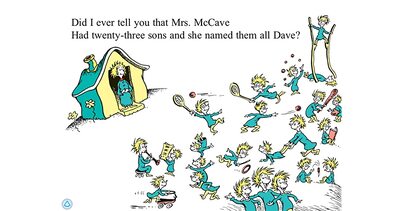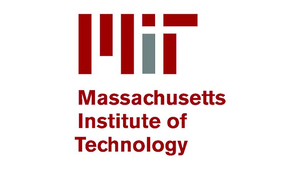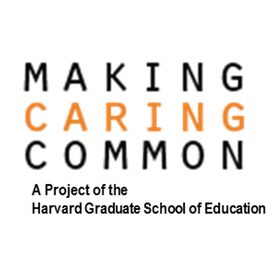 Copyright Dr. Seuss Copyright Dr. Seuss When I was a little kid, I loved the Dr. Seuss poem, “Too Many Daves.” I even memorized it and performed it for my class in 5th grade. The characteristically irreverent poem tells the story of Mrs. McCave, who “had twenty-three sons, and she named them all Dave.” Seuss then goes on to explain what she could have named them instead. The list features prospective names from Moon Face to Weepy Weed to my childhood favorite, Zanzibar Buck-Buck McFate. The consensus at the end of the poem is that Mrs. McCave made a terrible mistake, and the result is too many Daves. The reason I bring this up is the terrible mistake that I see many seniors about to make: too many reaches. As we get closer to the beginning of the new school year, I’m starting to work with my students on finalizing their college lists. We won’t have everything nailed down for another month or so, but my students are beginning to identify their favorite schools in the reach, target, and safety categories. And I’m having the same conversation with almost all of them about the downsides of making your list too reach heavy. The first reason I advise against applying to five or eight or ten reach schools is just the sheer amount of work involved. Reach schools for most students tend to be those highly-selective colleges that most of us can name easily (the ones that begin with Ivy and end with League). These schools also tend to require more supplemental essays, and their essays are more complicated. For instance, Stanford asks students to answer 11 additional essay questions. Many of those questions are quite short, but the topics are unique and don’t overlap with other colleges’ questions. The application fee is also $90, so applying to Stanford is not something to be done lightly. Writing 11 essays for Stanford is a perfectly reasonable thing to do when Stanford is one of eight or nine colleges that you’re applying to. You can do a great job on those 11 essays, you can spend as much time as you need to brainstorm just the right topic, and you can do all the necessary revisions to get your tone and your wording exactly right. But when Stanford is one of 15 or 20 schools on your list, those 11 essays are going to get short shrift. And while the chance of getting accepted to Stanford is comically low, you will definitely have a better shot if you knock those essays out of the park than you will if you rush through them a week before the deadline. So applying to fewer reach schools actually works in your favor by allowing you to do a better job on those applications and genuinely put your best foot forward. But it also benefits you months later when you get your admissions decisions. It’s very easy to underestimate how disappointing it feels to get a no from a college, even a college that you knew was a long shot. In December, it feels like throwing another piece of spaghetti at the wall – it’s no big deal. But in April, every small envelope, every letter that begins “I’m sorry to inform you…” is painful. Getting two or three of those decisions is manageable; it’s just a part of life. But getting five or eight or ten of those no’s can feel crushing. And it can undermine the excitement you should be feeling about the schools that said yes to you, the schools that are psyched about you, the schools that want to give you scholarships and throw you a tiny parade. So make a good choice for your future self and resist the urge to play admissions lottery, to buy just one more ticket, to apply to just one more school. Pick a smart list of schools with a manageable number of essays and do your very best on every single one of them. That way you’ll know, whether the decision comes back yes, no, or maybe, that you took your best shot.
0 Comments
 Photo by Artem Maltsev on Unsplash Photo by Artem Maltsev on Unsplash This week, I’ve had a number of parents reach out to me with just an edge of panic in their voices. This is understandable. We’re three weeks out from the start of the new school year, and things don’t look much different than they did last spring. Parents – and students – are worried about another round of online school, more SATs and ACTs getting canceled this fall, and extracurriculars getting put on hold for another season. This anxiety is entirely reasonable, and there are a million different rules, recommendations, and guidelines swirling around, which only makes it feel more chaotic. But I always think that the best response to anxiety is information, so I wanted to tackle a few of these topics. Will my school’s reopening impact my college applications? Every town, city, county, and state is operating slightly differently when it comes to reopening schools this fall. I’ve had students from high schools 10 minutes apart tell me about their school’s plans to go completely remote, or go to school two days a week, or go to school on a completely normal 5-day schedule. Some of my students have expressed concerns that this thing that is out of their control – whether and how their school resumes next month – will have a negative impact on their college plans. And the answer from colleges is, emphatically, no. Colleges know that the world looks very different right now than it did last year. They know that the school day looks different, engagement with teachers looks different, after-school activities look different. They’re not using the same rubric to assess students. Which means kids now have an opportunity to create new versions of their previous life that maybe even work better for them. My STEM kids are coordinating experiments in garages and driveways for their biology, chemistry, and physics classes. My performing arts students are trying to invent new ways to rehearse and produce shows on virtual stages. And my leadership kids are brainstorming socially-distanced ways to instill a sense of community and spirit among their fellow students. Will I be able to take the SAT or the ACT this year? The only responsible answer to this question is I don’t know. I’ve never been shy about my hope that standardized tests will play a smaller and smaller role in the application process, but I feel an unexpected sympathy for the decision-makers at College Board and ACT who are trying to balance the needs of all their individual stakeholders. Just this past weekend, ACT moved forward with their July ACT administration at a limited number of test sites, and then had to inform families that two students had subsequently tested positive for COVID-19 and many students and administrators had been exposed. So when my students ask me if they should study and take the test in August or November or March, I genuinely don’t know. My expectation (my hope?) is that tests will be on a more regular schedule next spring, that classes will be more in-person and high schools will be able to serve as test centers for weekend SATs and ACTs again. If you’re a senior planning to take the test this fall, I would encourage you to be prepared for those tests to get canceled. And if you’re a junior trying to set up your testing timeline, you’re more likely to need to test in the fall of your senior year. But, you’re also likely going to have many more test-optional colleges to choose from as well. So far, colleges have demonstrated reason and compassion in their policies, recognizing that if students can’t take the test, then they can’t submit it. My recommendation is to do your best, prepare if you can and test if you can, and then trust that colleges will understand if things don’t work out the way you planned. Will colleges judge me for my suddenly empty schedule? Again, the answer from colleges is a resounding no. Colleges get that your spring swim season was canceled. And now your fall water polo season has been canceled. Colleges understand that your monthly visits to a local assisted living community is not only canceled but flat out dangerous in the middle of a pandemic. Colleges know that our current economic crisis means that no one is hiring inexperienced teenagers to work part-time this summer. So take a deep breath and try to relax. Whatever you’re doing during this time is fine. If you’re practicing self-care and working your way through the Disney+ catalog, that’s fine. If your big outing every day is walking the family dog, that’s fine. If your biggest accomplishment this summer was finishing a 1000-piece 3D puzzle of the Colosseum, that’s fine. And if you’re bored and you want to find something bigger to do, we have a whole list of great options on the Collegewise website.  Photo by Richard Dykes on Unsplash Photo by Richard Dykes on Unsplash As I sit down with students every week to brainstorm and outline their essays, I’m continually reminded that the essay is a unique opportunity in this process, a real chance for students to articulate what matters to them and to share that with colleges in their own voices. It’s the closest most students will come to having a conversation with the person on the other side of the desk, not to make their case necessarily, but just to become a real, live, unique human being, rather than a stack of papers. And while some students delight at that chance, others find it deeply intimidating. In a recent meeting with a student, he confided that he was nervous about writing his first draft, that he didn’t think he was a very good writer, and while he had good ideas in his head, he had a hard time translating that to the page. I tried to put him at ease, telling him that this was just a first draft and we’d have plenty of time to develop it and strengthen it and tweak it to make it better and better. I also told him that this kind of writing is incredibly different from the other types of writing he’s done in the past, mainly formal academic writing. Because this is a new style of writing, more personal and conversational, I hoped he would find it easier to approach. But just in case that wasn’t true, I also shared a few workarounds that I use when I feel stuck. Record and Transcribe: Sometimes, we have a much easier time speaking our ideas than writing them down, particularly when we’re trying to tell a story. And the goal with a college essay is to nail that conversational tone, which may be easier to do if you’re actually talking out loud. One thing I suggest is recording yourself telling the story and then transcribing it. From there, you can edit it into more of a cohesive narrative and even move different sections around if you find a better flow. For students who are having a particularly hard time taking the first step, this can be really helpful. Send an Email: There is something so intimidating about the blinking cursor at the top of a blank Word or Google document. It’s just sitting there, waiting impatiently, metaphorically tapping its foot until you do something. Ugh. But I never feel the same pressure with a blank email window. I send emails all day, some long, some short; some I’ve given a lot of thought to, and some I’ve just dashed off. But emails somehow feel like much less of a big deal than a document. So try to write your essay in an email. You can even start off by talking to a friend or family member before you get into telling them your story. Again, this is a conversation, so don’t be afraid to make it feel that way. (Note: I do NOT recommend formatting your actual college essay as an email to a friend; this is the kind of gimmick that seems like a brilliant idea but is usually just a distraction.) Start in the Middle: Many students feel pressure to nail that first line of their college essay, to make it dramatic and attention-grabbing without being cliché. But sometimes, they focus so much on perfecting that first line that they can’t do anything else until it’s done. If that sounds like you, don’t start at the beginning – start in the middle. When I brainstorm an essay with a student, I send them off to write with a detailed paragraph-by-paragraph outline of the overall arc of their story. There’s no reason they have to start with paragraph one and then write paragraph two and so on. We spend a lot of time in the editing process adding and adjusting transitions between paragraphs anyway, so feel free to start in the middle. And maybe once you know where the story is going, you’ll have a better idea of how it starts.  MIT is in my blood. No, I’m not an alum. No, I’m not even a big math and science person. But MIT is where my parents met many decades ago. My dad used to take newborn me to the MIT library while he finished his dissertation. I knew the words to the MIT fight song, or “Beaver Call,” before I had any idea what I was saying (sample lyrics: Cosine, secant, tangent, sine, 3 point 1 4 1 5 9!). And when I was in grad school just across the Charles River, my friends and I would take full advantage of the MIT library’s reciprocity agreement and borrow all their books on literature and poetry. So even though I didn’t go to MIT, and I only have a few students who apply there each year, I find myself paying a little extra attention to it. As an alumna, my mom gets regular communications from the university about local events or campus initiatives. This week, she got an email about MIT’s plans for the fall semester, and she passed it along to me. We were both impressed with the way they’re approaching this situation, and how they immediately contextualized their response in the most MIT way possible as “broadly consultative, science-based and intensely analytic.” Their plan is thoughtful, flexible, compassionate, and with an eye toward equity. In fact, MIT has taken many excellent steps in response to the current crises facing college students and applicants this fall. They have led the way on permanently dropping SAT Subject test requirements, offering financial relief for students, and joining Harvard in a lawsuit against the newly implemented visa restrictions that would place a severe burden on international students. But all of this rings hollow when they have yet to do one of the simplest things to increase college access and equity for students this year: implement a test-optional policy. Every SAT in 2020 has been canceled so far this year and the ACT has only been given twice at a heavily reduced capacity. According to Inside Higher Ed, two-thirds of prospective applicants have yet to take a single SAT and three-fourths of applicants have yet to take the ACT. As 38 states see rising cases of COVID-19 this summer, there is little reason to think that students will be more able to take the test this fall. MIT is not even in line with its peers. According to FairTest, 60 of the "Top 100" national universities have already implemented test-optional policies for this year's applicants, including all of the Ivy League schools. At this point, the only notable holdouts in offering test-optional paths are public school systems that require state legislative approval to make that kind of change. Public university systems and MIT. And we know that the vast majority of students who will struggle to meet this requirement are low-income and first-gen students who are predominantly Black and Brown. As a global symbol of the power of science, reason, and facts, MIT should be a leader in this kind of fair and reasonable policy-making. Instead, they are on the wrong side of this decision, the wrong side of equity for students, and frankly, they’re on the wrong side of science.  Earlier this week, 300 colleges signed a very welcome paper addressed to students applying to college this fall in the midst of a global pandemic and recession. Titled Care Counts in Crisis: College Admissions Deans Respond to COVID-19, it was published by the Making Caring Common Project at Harvard’s Graduate School of Education. Just reading their mission statement soothes me and makes me optimistic for the future of humanity: “Our vision is a world in which children learn to care about others and the common good, treat people well day to day, come to understand and seek fairness and justice, and do what is right even at times at a cost to themselves. We believe that young people with these capacities will become community members and citizens who can strengthen our democracy, mend the fractures that divide us, and create a more caring, just world.” One of their reports specifically addresses the role that this kind of behavior can play in the college admissions process: Turning the Tide: Inspiring Concern for Others and the Common Good Through College Admissions. In the report, they encourage college admissions offices to prioritize “concern for others […] among high school students,” and in this way to create greater access for disadvantaged students and to lower the pressure and anxiety that many students feel about applying to college. So I was thrilled to see colleges look inwardly and demonstrate their own caring toward the students they engage in the admissions process. I was thrilled to see colleges use the power and influence they have over teenagers who are desperate for their approval to make things a little easier, a little better, and little kinder right now. In Care Counts in Crisis, they identify five things that they value in their applicants at this moment: 1. Self-care: “We […] recognize that this time is stressful and demanding for a wide range of students for many different reasons. We encourage all students to be gentle with themselves during this time.” 2. Academic work: “We recognize that you may face obstacles to academic work. We will assess your academic achievements in the context of these obstacles. […]No student will be disadvantaged because of a change in […] plans because of this outbreak. 3. Service and contributions to others: “We value contributions to one’s communities for those who are in a position to provide these contributions. We recognize that […] many students are not in this position because of stresses and demands.” 4. Family contributions: “Many students may be supervising younger siblings, […] or caring for sick relatives or working to provide family income, and we […] view substantial family contributions as very important. 5. Extracurricular and summer activities: “No student will be disadvantaged for not engaging in extracurricular activities during this time. […]We have never had specific expectations for any one type of extracurricular activity or summer experience and realize that each student’s circumstances allow for different opportunities. And beyond just reassuring students that they “emphatically, do not seek to create a competitive public service ‘Olympics’ in response to this pandemic. [That] what matters […] is whether students’ contribution or service is authentic and meaningful to them and to others,” they are also encouraging students to take action for the things they believe in. Because while we are currently dealing with a deadly virus and a devastating economic downturn, we have been dealing with and continue to deal with systemic racism and sexism, climate change, and income inequality. So if you’re feeling called to “forms of contribution that are unrelated to this pandemic, such as working to register voters, protect the environment, combat racial injustice and inequities, or stop online harassment among peers,” colleges are fully on board with that too. This is exactly the conversation I’ve been having with my students for the last few months, reassuring them that colleges will understand that second-semester grades are pass/fail, that the internship they got at a local hospital was canceled, that their plans to work this summer and save money are no longer feasible. I believed that colleges would genuinely look at a student in the context of everything that is going on and make decisions with generosity. But it is really nice to have that in writing, from eight pages worth of colleges like Yale, Georgia Tech, and University of Colorado Boulder. So thank you, colleges, for putting your names on this, for walking the walk, and for showing students that caring in college admissions is, in fact, common. |
What is the When I Was 17 Project?When I Was 17 is a blog series dedicated to collecting the varied stories of people's career paths, what they envisioned themselves doing when they were teenagers and how that evolved over the course of their lives. I started this project with the goal of illustrating that it's okay not to know exactly what you want to do when you're 17; many successful people didn't, and these are a few of their stories.
Archives
October 2020
|